Where will children learn about nature?
There has been so much building and housing in Japan that we’ve lost open space and natural areas. Where will children learn about nature? Where do they engage with the nature world? To solve this problem, we wanted to design biotopes within school grounds. These spaces would serve as both play and engagement areas. They also serve real ecological functions as natural areas.
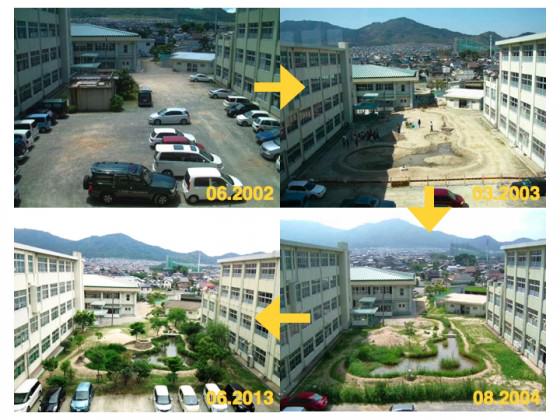
Creating a school biotope project over 10 years
This project was started in 2003 by creating a school garden for children to play in and to help restore nature to a small part of Fukuoka City in southern Japan. The garden continues today. We have been creating an area for children’s play and ecological education that can also form part of an ecological network in the urban area.
This area of the city has been developed mainly as a residential area with about 50 percent of its original green spaces (paddy fields, forests and grassland) having been lost over the last 40 years. However, there are still a number of streams, ponds, and other green spaces remaining on the planning site. The planning site was a courtyard in Ikiminami-primary school in Japan.
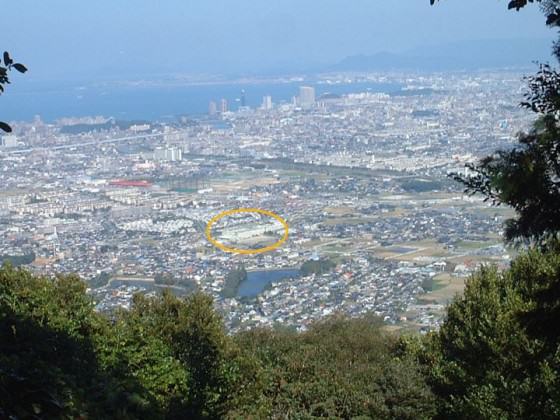
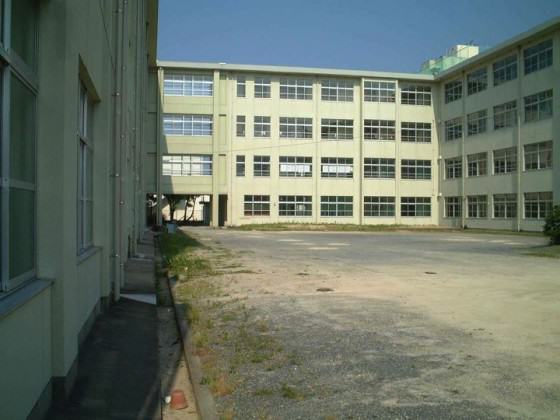
Problems with school biotopes in Japan
In Japan, many school biotopes have been created using a number of different methods. Some of them have been successful but many have failed and are abandoned. The main reasons for failure are the following:
1) The children are not allowed to approach the biotope because of an emphasis on the protection of the ecosystem.
2) Failure by the planners to consider the regional ecosystem, which has led to the destruction of that ecosystem.
3) The biotope is too small to have an ecological function.
4) The children and teachers of the school do not use the biotope because it was planned and constructed by the local council without their participation.
Methods for the planning and design
So I thought to try two new ways of planning and design: process planning (a time scale approach) and multi-functional landscape planning (a space scale approach). The architect Arata Isozaki (1970) described 3 different types of planning process.
1) “Closed planning”, which takes every aspect of the planning process into consideration.
2) “Open planning”, which focuses on development for the future.
3) “Process planning”, which focuses on the planning process itself and not solely the end form.
Here, “Process planning” was used to plan the school garden given the length of time the process was expected to take.
Multi-Functional Landscape Planning (a space scale approach, seen below), “MFLP” (Ito et al., 2003, 2010) was used to plan the school garden for space scale planning. In other words, this is a method to think about how to manage the space for various uses. According to this method, the space is divided into a number of layers (layers of vegetation, water, playground and ecological learning), which overlap each other. However unlike “zoning”, MFLP does not divide a space into clear functional areas. The overlapping of layers creates multi-functional areas where, for example, children who are playing by the water can also learn about ecology at the same time. Thus, during the creation of a multi-functional play area, children are able to engage in various activities as its different layers are added on top of each other. In addition, they can learn something new about its ecology while they are playing there.
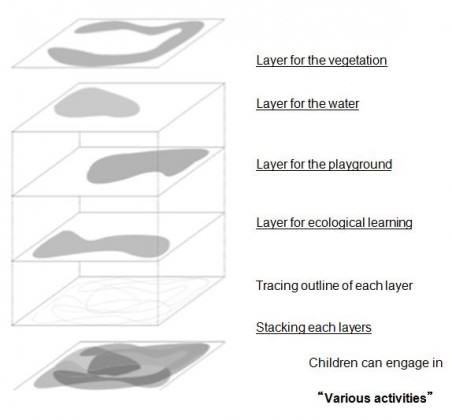
Children, university students, and teachers participation
Planning workshop:
Children at the school, their teachers and students of our Lab participated in the planning and construction phases of the project and in making improvements to the school biotope. The children made lots of suggestions for the water biotope, in particular regarding the shape of the bridge and the depth of the water. They also came out in favour of planting fruiting trees to attract birds and evergreen and deciduous trees to attract small animals and insects. In this way, they were able to gain a basic knowledge of the regional ecosystem and its flora and fauna.
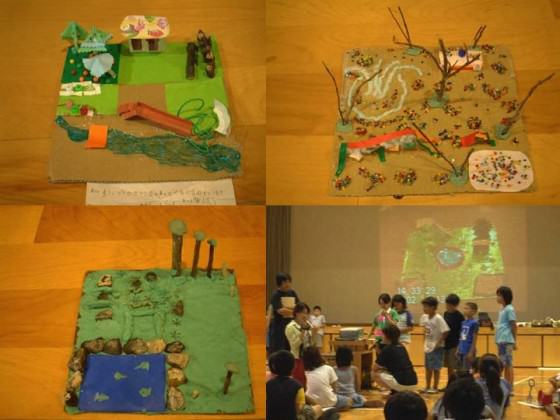
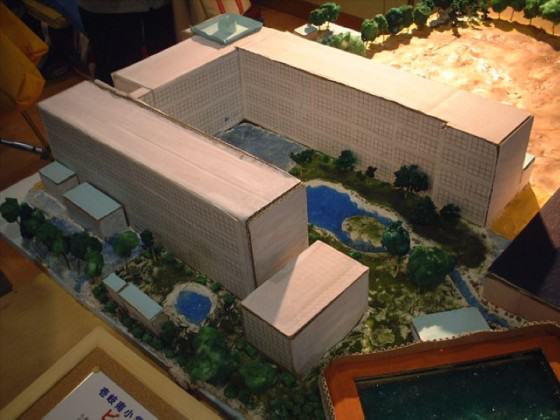
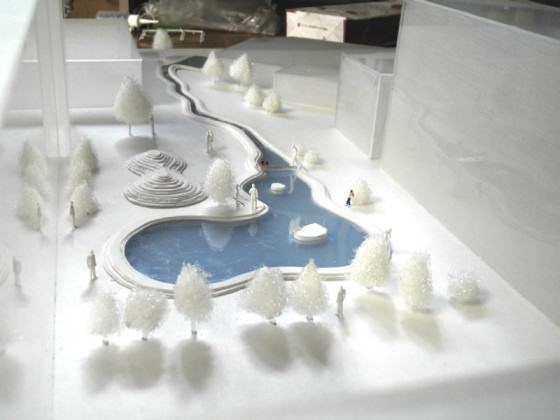
Construction workshop:
From January 2003 to March 2003, we visited the school to give classes and oversee the construction of the biotope. This process involved the same 83 school children, 20 teachers and 12 students from Kyushu Institute of Technology. The process of the construction was a really enjoyable time for children, teachers and university students because their ideas were realized in every workshop.
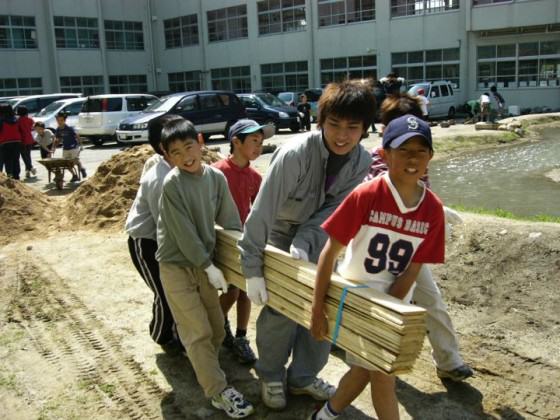
Using workshops:
Between April 2003 and the time of writing, July 2013, 230 workshops have been held to make improvements to the biotope. These included the construction of a new bridge, a water purification project and more discussions which particular species the children wanted to attract to the biotope. Through these workshops, we have fulfilled our original goal of enabling the children to directly experience the life cycle of plants and changes in the local fauna.
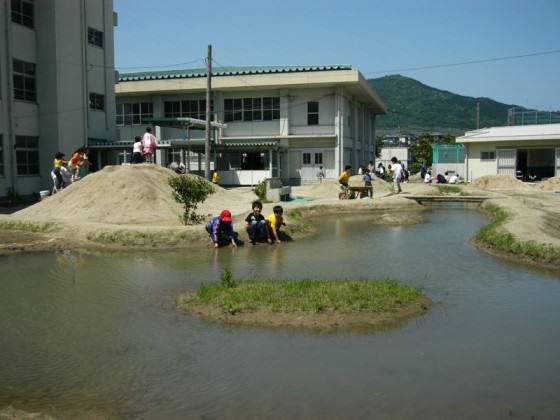
Importance of the process design
“Process planning” (Isozaki, 1970) was used in the planning and design phases of this project. This does not place emphasis on the finished object but allows changes to be made during the actual process and is thus a very flexible method of design. The children have learned about the existence of various ecosystems when playing in the biotope and through their participation in the various workshops.
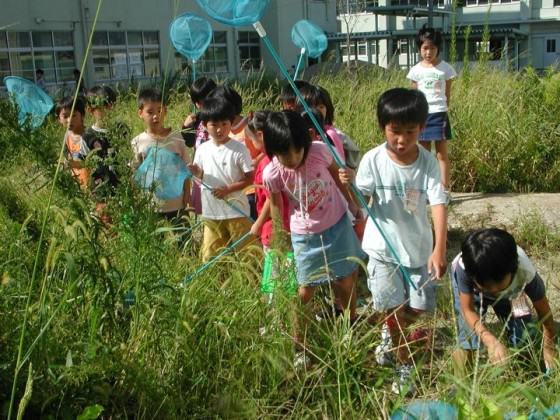
MFLP provides a variety of activities for the children as they are able to learn more about nature when they play in the biotope. Some children enjoyed running around, jumping from one side of the stream to the other side or just sitting there and talking whilst others were observed trying to catch insects or just looking at the grass and flowers. 186 kinds of play were observed in the biotope.
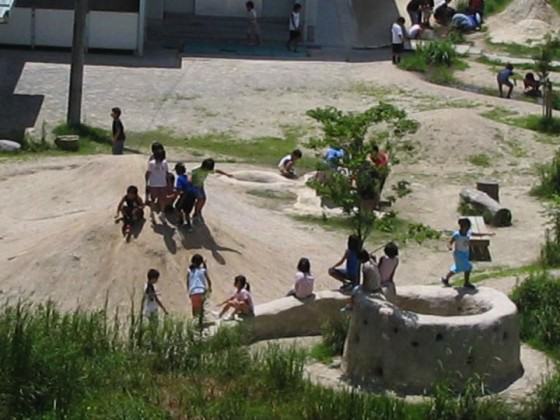
Affordances for the design:
Gibson’s theory of affordances (1979) was used for the design. The children’s activities corresponded according to the composition of the environment’s function. According to his theory, perception of the environment inevitably leads to some course of action. This biotope not only provides the children with a place to play in a variety of ways but has also become a habitat for a number of living creatures such as birds, insects and fish.
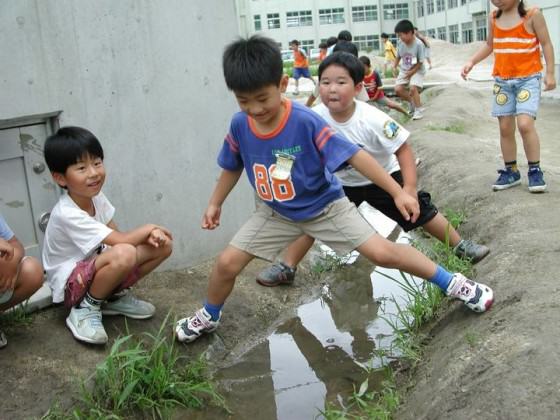
Biotope network in urban area
This biotope succeeded in attracting various birds (for example, the grey heron, Ardeas cinerea) to the site. Mallards (Anas platyrhynchos) were born in the biotope. It was suggested that the biotope could become one of a number of habitats for birdlife in this urban area. The school garden has gradually changed into a biotope over the past ten years and the ecosystem contained in it has become more complex every year. This type of school biotope would contribute to the ecological network in the city.
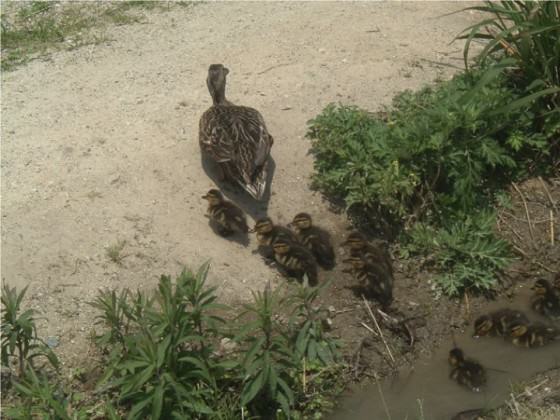
The children have learned about the existence of various ecosystems by playing in the biotope and through their participation in the workshops during the planning of it. The teachers and local residents have also been active in this process and have actively participated in the development of an accessible environment and been able to propose ideas for its future management.
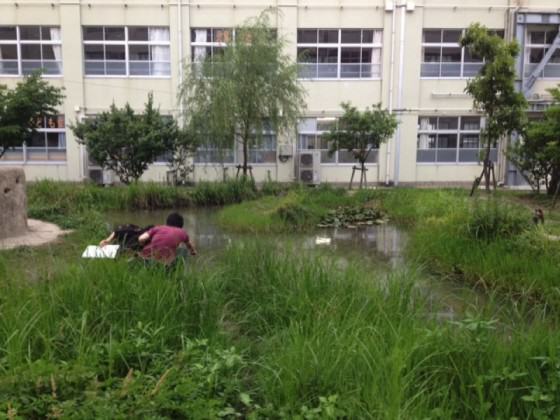
Consider “landscape” as an “Omniscape”
A lack of outdoor space to play in, fear of violence in public spaces, the longer working hours of parents, and the artificial nature of most playgrounds have helped create the present-day situation in which young children have gradually lost contact with nature. It is thus vital that planners and landscape designers consider “landscape” as an “Omniscape” (Numata 1996, Arakawa, 1999). It will be more important to think that landscape planning should embrace “the five senses”; not only sight but also touch, taste, hearing and smell (and more?).
Keitaro ITO
Fukuoka, Japan
References
Gibson, J. (1979) The ecological approach to visual perception, Houghton Mifflin Company, Boston
Isozaki, A. (1970) Kukan e (Toward the space), bijyutu shuppan, Tokyo (in Japanese)
Ito, K. Masuda, K., Haruzono, N., Tsuda, S., Manabe, T., Fujiwara, T., Benson, J., Roe, M.(2003) Study on the biotope planning for children’s play and environmental education at a primary school –The workshop with process planning methods-, Environmental Systems, 31, 431-438 (In Japanese with English summary)
Ito, K., Fjortoft I., Manabe T., Masuda K., Kamada M., Fujiwara S., (eds.) N. Muller, P.Werner, J.G.Kelcey (2010) Urban Biodiversity and Design, “Conservation Science and Practice Series”, Landscape Design and children’s participation in a Japanese primary school – Planning process of school biotope for 5 years -, Wiley-Blackwell, Oxford, UK, 441-453
Numata, M.(1996) Landscape Ecology, Asakura shoten, Tokyo

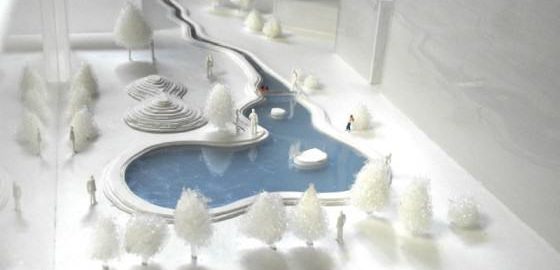






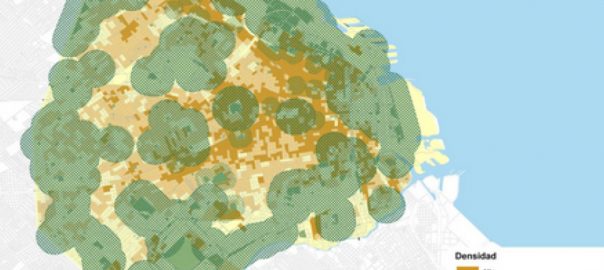

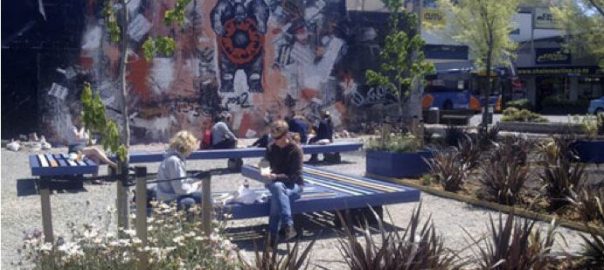

Dear Djafri, Thanks for your comments! Wonderful to hear that! Yes…It has been quite long process and stories… You would read part of it on “urban biodiversity and design” edited by Prof. Norbert Muller, Peter Werner, John Kelcey, Willy Blackwell pub. also we are now challenging several places and goin on…some example of our projects. Glad if you are interested in…
http://keitaro-ito-lab-kit.businesscatalyst.com/keitaro_en.html
http://www.thenatureofcities.com/author/keitaroito/
https://www.youtube.com/watch?v=-15cjwPPMQY
Thanks to this website managing, Dr. David Maddox,
Best wishes, Keitaro
Dear Djafri, Thanks for your comments! Wonderful to hear that! Yes…It has been quite long process and stories… You would read part of it on “urban biodiversity and design” edited by Prof. Norbert Muller, Peter Werner, John Kelcey, Willy Blackwell pub. also we are now challenging several places and goin on…some example of our projects. Glad if you are interested in…
http://keitaro-ito-lab-kit.businesscatalyst.com/keitaro_en.html
http://www.thenatureofcities.com/author/keitaroito/
https://www.youtube.com/watch?v=-15cjwPPMQY
Thanks to this website managing, Dr. David Maddox,
Best wishes, Keitaro
I am so impressed with your project and its success. The amazing part of it is that children also took part in the process, so they also feel responsible for it. It is really nice!
I am wondering about one thing though. Is public parks and natural conservation areas in Japan were made based on the landscape ecology concept too?
Mark, Thanks for your comments! Yes, In this project, we had some survey about children’s play in other place when they go back from the school or their play in Saturday/Sunday. There are some places like ponds (usually covered by concrete), river and some parks, but it is difficult to play for them at ponds and river because of their safety…They are sometimes play in some parks with the play structure. So, there are few chances to play with nature near there, that is one reason to create school biotope like this.
Keitaro – great blog. Are any of the children taking what they have learned to their homes or neighborhoods? In other words, are the creating native habitats outside of the playground?